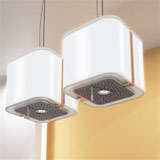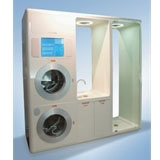Profile: Alessandro Finetto

Whirlpool’s Alessandro Finetto aims to rethink domestic appliances and create total environmental experiences. Mark Delaney talks to a man who is placing design innovation at the heart of business strategy
Alessandro Finetto is a man on a mission to humanise domestic appliances, a notoriously conservative product category. True innovation is rare and change happens slowly. Combined with low profit margins and fierce competition from Asia, this is a tough market sector to design for.
With more than 25 years in the industry, one might expect Finetto to be jaded and resigned to the status quo. In fact, quite the opposite is true. Finetto is an extremely enthusiastic and articulate designer, energised by the potential of design to redefine mature product categories and make products like the humble refrigerator relevant to our emerging 21st century lifestyles. As well as dealing with the design of the day-to-day products we see in the shops, Finetto and his team provide Whirlpool with a long-term design vision through biannual strategic design projects that interrogate a certain aspect of how we integrate domestic appliances into our lifestyles.
Finetto began his design career in 1989 by joining the Philips Design centre and, following Whirlpool’s purchase of Philips’ European major domestic appliances business, designing microwave ovens. After then heading the design studio for the Bauknecht brand, he was last year appointed Whirlpool global director of consumer design, overseeing the design of all European products for the Whirlpool and Bauknecht brands.

In the right hands, strategic projects have the potential to be an extraordinarily valuable planning tool. However, they all too often amount to little more than irrelevant eye candy, as designer ego takes over from consumer needs and technology is deployed to solve problems that didn’t really exist in the first place. Finetto and his team prevent their work sliding into irrelevance through a combination of research-driven insight, social trend analysis and technological innovation, which allows them to arrive at product ideas that are challenging and valuable to the business.
These strategic design projects began in 2000 under the guidance of then design director Richard Eisermann (who has since set up his own consultancy after leaving the Design Council). Under Finetto’s leadership, these biannual concept projects have grown in size and complexity. The most recent project, InHome, launched earlier this year at Eurocucina in Milan, takes white goods out of the kitchen into the wider context of the living space. What makes these projects so interesting is the progression from Macrowave five years ago, which showcased the (very interesting) stylings of a few celebrity designers, to InHome, which displays a more thoughtful approach, based upon the needs of the customer.
Finetto is keen to stress that while many of the results of these projects are undoubtedly radical in both thinking and execution, these are not simply dream products for dream lifestyles. The starting point for each conceptual project is grounded in a period of thorough research and analysis, which begins with Whirlpool researchers and designers carrying out a number of home visits across Europe, spending time with real people to observe how they go about their day-to-day household chores and understand how they view their self, home, family and friends. Through painstaking analysis, Finetto and his team identify a number of potential opportunities. These are further refined into specific lifestyle scenarios, which form the foundation of the design brief.

Projects such as InKitchen and InHome have seen Finetto and his team moving the Whirlpool brand beyond the limitations of defined product typologies to create total environmental experiences, which combine the cultural design values of furniture with the ambient mood qualities of lighting. The Lighthood extractor fan, with built-in mood lighting, and InTable, with its built-in heating and cooling elements, respond to the consumer’s desire to integrate the kitchen back into the heart of the home and create a more sociable cooking experience. Finetto says this experiential approach to domestic appliances is an area that Whirpool is keen to explore further, hinting at a number of interesting real-life collaborative projects with the masters of the mass-market kitchen, Ikea.
Perhaps what is most impressive about Finetto’s recent achievements is his ability to place product design innovation at the heart of the Whirlpool brand. Through a combination of design skills, determination and corporate savvy, he is communicating the value of design at board level as an integral part of a multidisciplinary effort to shape future business strategy, and for that he should be applauded.
-
Post a comment




